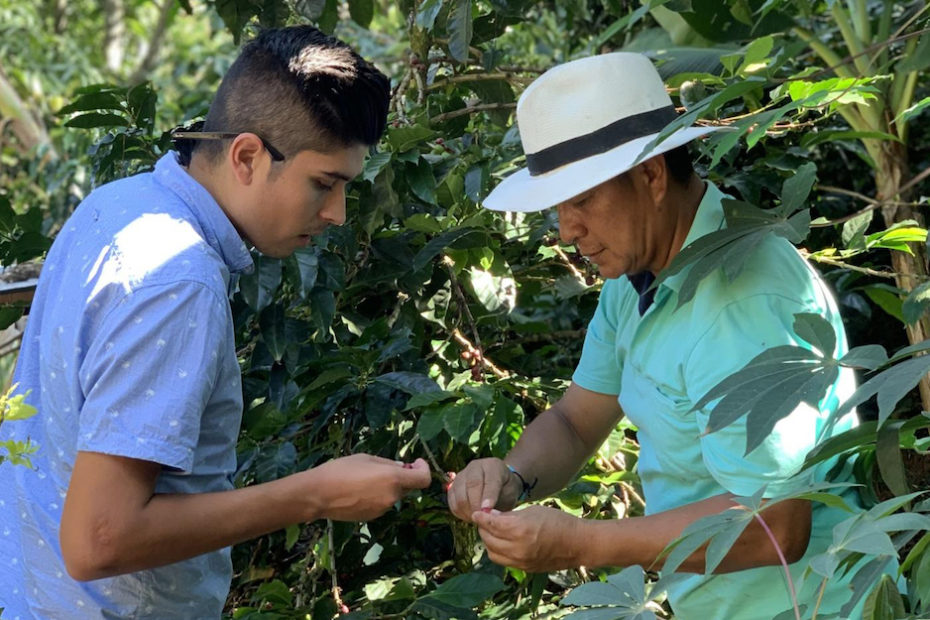BY PERFECTDAILYGRIND – Indigenous communities are some of the most underrepresented and overlooked groups in the coffee industry. Yet the indigenous population of Colombia alone is estimated to number around 1.5 million people – representing about 3.4% of the total population. In rural areas, many of these communities depend on the coffee industry for their income.
Indigenous peoples’ histories and traditional cultures mean they often have a unique heritage of coffee production unlike other farming communities. However, in many cases, the challenges these groups face when selling their coffees are often not fully addressed by the wider coffee industry.
Understanding the complex histories of these communities is essential when it comes to talking about indigenous-grown coffee in Colombia. To learn more, I spoke with Daniel Jaramillo, the owner of Antioqueña de Cafés Especiales, and Lisardo Domico, a member of the Colombian Emberá Chami indigenous tribe. Read on to find out what they said.
AN OVERVIEW OF COLONIALISM IN COLOMBIA
Spanish colonial settlers first arrived in Colombia in the early 16th century. European colonists often introduced coffee to indigenous communities – including countries in Latin America, Africa, Asia, and the Caribbean – as a profitable, yet exploitable, crop.
It’s believed that the first record of coffee production in Colombia was in missionary priest José Gumilla’s book in 1741.
Coffee production in many countries has an inherent link to colonialism, but indigenous communities have arguably experienced the most severe forms of exploitation. In many cases, these groups were forced out of their homelands into areas where coffee production was more profitable for colonial powers.
Today, despite the fact that many of these former colonies have since become independent, the prevailing structural issues caused by colonialism continue to be prominent for indigenous coffee producers.
Of the many coffee-growing regions in Colombia, the Sierra Nevada de Santa Marta mountain range, and the Antioquia, Caldas, and Nariño departments are home to several indigenous coffee-producing communities.
Lisardo’s tribe is located near Ciudad Bolívar in Antioquia, but the group is actually indigenous to the Chocó department in western Colombia. The Emberá are Colombia’s third-largest indigenous population, estimated to comprise around 71,000 people.
Lisardo explains how coffee became an important crop for the Emberá tribe.
“When my tribe was pushed out of Chocó and migrated to Antioquia, we arrived in fields of coffee trees,” he says. “From there, we understood coffee to be a cash crop and a form of income for our community. Since then, we have adapted to the challenges of coffee production.”
While this story is unique to the Emberá Chami tribe, each of Colombia’s indigenous coffee communities has its own personal experience with growing and selling coffee. Other indigenous tribes, such as the Arhuacos of the Sierra Nevada de Santa Marta and the Awá of Nariño, also became exposed to coffee production because of colonialism.
HOW DO THE LASTING EFFECTS OF COLONIALISM CONTINUE TO AFFECT INDIGENOUS PEOPLE?
Although indigenous communities in Colombia have largely become self-governing, coffee production still remains vital for the livelihoods of many of these groups.
Similar stories have played out in various coffee-producing communities around the world; several generations of indigenous tribes can often remain dependent on growing coffee as their main source of income.
Unfortunately, many indigenous people still face legacy issues caused by existing colonial structures.
Value addition mainly takes place towards the end of the coffee supply chain, as this is where coffee is roasted and sold. This means that producers often receive disproportionately less money for their coffees despite being integral to the global coffee market.
The present system with the global price of coffee also means that producers tend to have little to no say in the prices they receive from selling their coffees. While this is changing in some ways, producers are still at the mercy of price fluctuation, which is often out of their control.
Many indigenous producers are also dependent on foreign parties who operate mills and processing facilities. While these parties usually extend credit to producers, this can lock farmers into set prices for several years at a time.
This potentially leads to them losing out on increasing their income: if the market price for coffee increases, these producers are still tied into a lower rate.
Thankfully, calls for market reforms and further social initiatives are helping to embolden farmers. More producers are beginning to recognise the value of their coffee, while gender equity initiatives are supporting women to attain leadership positions in coffee production.
In some instances, coffee can be used as a tool by indigenous communities to avoid further exploitation. One example is the Doi Tung Development Project in Thailand which supports indigenous coffee farmers.
The Chiang Rai region forms part of the “Golden Triangle”: an area bordering Thailand, Laos, and Myanmar. Opium, arms, and human trafficking have all historically been prominent in this area.
However, through the project, indigenous farmers have been provided with plots of land to live on and produce coffee – helping them to become more autonomous and independent.

CHALLENGES FOR INDIGENOUS COFFEE PRODUCERS
The main challenges that many indigenous coffee communities face include a lack of infrastructure and poor quality control practices.
While indigenous communities are often self-governing and autonomous, they can also sometimes lack support from governments and other foreign parties.
Lisardo explains that indigenous groups typically sell their coffees as cherry, as they do not have access to the appropriate infrastructure for drying and processing coffee.
“For too long, indigenous communities have sold their coffee as cherry, which then leaves them in a circle of poverty,” he says. “We are not able to scale and reinvest into our farming community, which would lead us to be able to dry our coffees and have more control over the quality.”
This common lack of access to processing infrastructure ultimately creates barriers for many indigenous coffee communities looking to increase their income. However, Lisardo’s tribe has worked hard to create relationships with buyers who recognise the potential of these producers.
Daniel is the owner of a Colombian coffee trading company in Itagüí. He explains the subsequent importance of investing in infrastructure and education, especially where coffee quality is concerned.
“We formed a relationship with the Emberá Chami tribe which allowed us to invest in drying facilities,” he tells me. “The community can dry their coffees and sell them as parchment.” This means that farmers should receive higher prices as they have added value to the coffee after carrying out processing.
Daniel adds: “We also used this opportunity to teach the community about the importance of quality and how they can achieve higher quality coffees.”
There can also be transparency issues when purchasing coffees from indigenous communities, as these groups are often vulnerable to unethical trading practices.
In his experience working with indigenous communities, Daniel says there is often little financial literacy. This is because there is often low access to educational resources for these groups, as well as fewer opportunities to reach national and international markets.
To resolve these problems, buyers can ask indigenous coffee growers they work with if there’s anything they can support with in pursuit of a more productive long-term relationship. Without the right infrastructure and support, these communities are unlikely to improve coffee quality and yields on their own.

ACKNOWLEDGING CULTURAL DIFFERENCES
When it comes to purchasing coffee from indigenous communities, there are often prominent cultural differences which must be accounted for. However, many supply chain actors may not be familiar with these cultural practices.
In fact, unfounded stigmas around indigenous coffee communities producing low-quality coffees can be common, as Lisardo tells me.
“The stigma against indigenous coffee producers is unfortunate,” he says. “On top of that, we come from a region surrounded by many competing farms, so it makes it difficult for us to find buyers who are willing to invest in the long-term.
“However, our indigenous culture has shown that we are persistent in improving our coffees.”
Daniel explains: “These communities are accustomed to a communal way of life that is heavily based on the sustainability of nature, so there is little financial knowledge.”
He adds that when trading with indigenous producers, it’s about more than paying a fair price for their coffee. In his opinion, it’s more important to build long-term relationships that enable these communities to sustainably improve their livelihoods.
Around the world, indigenous coffee communities offer a uniquely important viewpoint in the sector which is rarely considered by the wider industry.
Their rich cultures and centuries of coffee-growing heritage mean they have the foundations to be important to the coffee sector of the future, despite any unfair stigma and misconceptions.
Credits: perfectdailygrind

